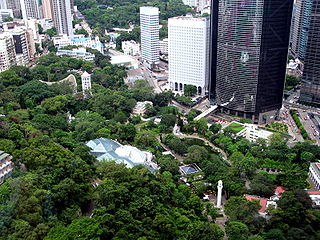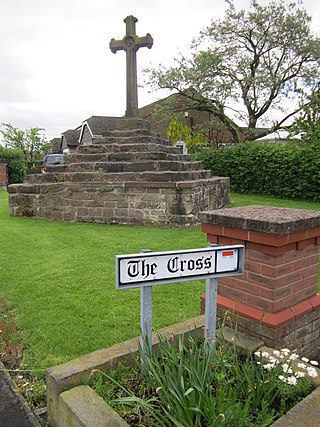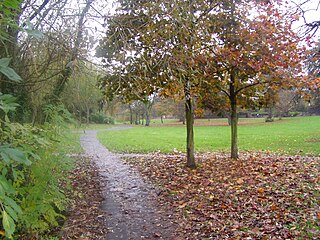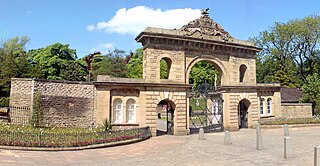
Hyde Park, Sydney, is an urban park, of 16.2-hectare (40-acre), located in the central business district of Sydney, in the City of Sydney local government area of New South Wales, Australia. It is the oldest public parkland in Australia. Hyde Park is on the eastern fringe of the Sydney city centre and is approximately rectangular in shape, being squared at the southern end and rounded at the northern end. It is bordered on the west by Elizabeth Street, on the east by College Street, on the north by St James Road and Prince Albert Road and on the south by Liverpool Street.

Hong Kong Park is a public park next to Cotton Tree Drive in Central, Hong Kong. Built at a cost of HK$398 million and opened on 23 May 1991, it covers an area of 80,000 square metres (860,000 sq ft) and is an example of modern design and facilities blending with natural landscape.

Toxteth is an inner-city area of Liverpool in the county of Merseyside.

The Macquarie Place Park, also known as the Macquarie Place Precinct, is a heritage-listed small triangular urban park located in the Sydney central business district in the City of Sydney local government area of New South Wales, Australia. The former town square and milestone and now memorial, public park and monument is situated on the corner of Bridge Street and Loftus Street. It is named in honour of Governor Lachlan Macquarie. The precinct includes The Obelisk or Macquarie Obelisk, the Sirius anchor and gun/cannon, the Statue of Thomas Sutcliffe Mort, the historic Underground Public Conveniences and the Christie Wright Memorial Fountain. The property was added to the New South Wales State Heritage Register on 5 March 2010.

Ince Blundell is a village and civil parish in the Metropolitan Borough of Sefton in the ceremonial county of Merseyside and historic county of Lancashire, England. It is situated to the north of Liverpool on the A565 road and to the east of the village of Hightown. There are two associated hamlets of Lady Green and Carr Houses.

Prince's Park in Toxteth, Liverpool, England, is a 45 ha municipal park, 2 mi (3.2 km) south east of Liverpool city centre. In 2009, its status was upgraded to a Grade II* Historic Park by English Heritage.

Corporation Park is a traditional Victorian park in Blackburn, Lancashire, England. It was landscaped by William Henderson and opened in 1857. Corporation Park is regarded as the main formal park in Blackburn and is used mainly by local people for general recreation, walking and dog walking, as well as for its tennis, bowling and football facilities.

The Church of St Agnes and St Pancras is in Ullet Road, Toxteth Park, Liverpool, England. It is recorded in the National Heritage List for England as a designated Grade I listed building, and is an active Anglican church in the diocese of Liverpool, the archdeaconry of Liverpool and the deanery of Toxteth and Wavertree. Pevsner described it as "by far the most beautiful Victorian church of Liverpool...an epitome of Late Victorian nobility in church design".

The Royal Botanic Garden, Sydney is a heritage-listed major 30-hectare (74-acre) botanical garden, event venue and public recreation area located at Farm Cove on the eastern fringe of the Sydney central business district, in the City of Sydney local government area of New South Wales, Australia.

Toxteth Park Cemetery is a graveyard on Smithdown Road, Liverpool, United Kingdom. It was opened on Monday 9 June 1856. It was the responsibility of the Toxteth Park Burial Board, which had been established by at least 1855.

Birkenhead Park is a major public park located in the centre of Birkenhead, Merseyside, England. It was designed by Joseph Paxton and opened on 5 April 1847.

Beacon Park is a public park in the centre of the city of Lichfield, Staffordshire, in the United Kingdom. The park was created in 1859 when the Museum Gardens were laid out adjacent to the newly built Free Museum and Library. The park has since been extended in stages and now forms 69 acres (28 ha) of open parkland in the city centre. The park is in the northwest of the city centre and to the west of the Cathedral Close across the road from the Garden of Remembrance.
Grade I, Grade II* and notable Grade IIlisted buildings in the metropolitan boroughs of Knowsley, Liverpool, Sefton, St Helens and Wirral in Merseyside.

The Dunedin Botanic Garden is located at the northern end of central Dunedin, in the South Island of New Zealand. The garden is close to the University of Otago and one of the city's most historic cemeteries, the Northern Cemetery, on a spur of Signal Hill and on the river plain immediately below it.

The Jephson Gardens are formal gardens, together with a grassed park, in the town of Leamington Spa, Warwickshire. The gardens, once a place for the wealthy to 'take the air' and 'be seen', are found in the centre of the town on the Parade, with the River Leam flowing to the south of them. One of the town's most popular tourist attractions, they have facilities such as cafes and floral displays. The gardens are often marketed in tandem with the nearby all-grassed Mill Gardens on the south side of the river. The gardens have a total area of 14.6 acres (59,000 m2) with Mill Gardens and its boating lake, both on the opposite side of the river, providing an extra 3.9 acres (16,000 m2).

Peel Park is a 22.6-hectare (56-acre) urban public park in the Bolton and Undercliffe area of Bradford, England, located about 0.75 miles (1.2 km) north-east of the city centre, and named after Sir Robert Peel (1788–1850). Peel Park was Bradford's first public park and is on the English Heritage and National Register of Historic Parks and Gardens online databases. The park is a Green Flag Award winner and has been for a number of years.

The architecture of Liverpool is rooted in the city's development into a major port of the British Empire. It encompasses a variety of architectural styles of the past 300 years, while next to nothing remains of its medieval structures which would have dated back as far as the 13th century. Erected 1716–18, Bluecoat Chambers is supposed to be the oldest surviving building in central Liverpool.
Liverpool is a city and port in Merseyside, England, which contains many listed buildings. A listed building is a structure designated by English Heritage of being of architectural and/or of historical importance and, as such, is included in the National Heritage List for England. There are three grades of listing, according to the degree of importance of the structure. Grade I includes those buildings that are of "exceptional interest, sometimes considered to be internationally important"; the buildings in Grade II* are "particularly important buildings of more than special interest"; and those in Grade II are "nationally important and of special interest". Very few buildings are included in Grade I — only 2.5% of the total. Grade II* buildings represent 5.5% of the total, while the great majority, 92%, are included in Grade II.

The Shaftesbury Memorial Fountain, officially and popularly known as Eros, is a fountain surmounted by a winged statue of Anteros, located at the southeastern side of Piccadilly Circus in London, England. Moved after the Second World War from its original position in the centre of the circus, it was erected in 1892–93 to commemorate the philanthropic works of The 7th Earl of Shaftesbury, the Victorian politician and philanthropist, and his achievement in replacing child labour with school education. The fountain overlooks the south-west end of Shaftesbury Avenue, also named after the Earl.

Toxteth Town Hall, formerly known as Toxteth Park Public Offices, is a municipal building in High Park Street, Toxteth, Merseyside, England. The structure, which currently operates as a community centre, is a grade II listed building.


































